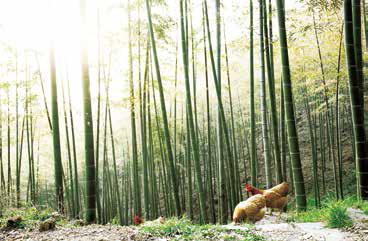Mount Mogan and Some Foreigners
Sun Wen
Mount Mogan, a unique mountain 60 kilometers from the provincial capital city Hangzhou of Zhejiang and 200 kilometers from Shanghai. It is unique not because the mountain boasts bamboo forests and bubbling streams. Known for its cool temperatures during the regions scorching summers, mountain has been a summer resort, first favored by the Shanghai elite such as missionaries, businessmen, customs officials and their families in the 1880s. by 1910 approximately 300 foreigners, mostly Americans and British, had set up summer homes on the hill. A lot of villas and houses they built still stand today. Some are hotels and guesthouses.
In 2015, Zhong Xiangping, Ye Quanxin and Liu Jianlin published a book titled Mount Mogan with the funds raised through crowdfunding online. Over the past four years, the book sold so well that it was reprinted in 2018. The new edition includes some new information on the geographic features in the area encircling the mountain and some villages and towns in the mountain area where ecology is well kept. Even the trio had not expected that the book has sold so well.

莫干山裸心堡。A view of Naked Castle situated on gentle rolling hills in Mount Mogan, first constructed by Dr. Duncan Main

莫干山風景。A rural view of Mount Mogan
It was no accident that the three authors collaborated in writing the book. Zhong Xiangping is a walking encyclopedia of the history and historical architecture of Hangzhou and surrounding areas. You name a time in Hangzhou, say fifty years ago, 100 years ago, or 200 years ago, and he can draw you a map telling you how the city looked back then. Ye Quanxin is a female writer from neighboring Anhui Province and now based in Hangzhou while Liu Jianlin, not a native of Mogan, has been working for the mountains administration for years.
The team did a thorough field study of the mount and the mount opened up to them. From the 1880s on, the mountain provided a convenient breakaway shelter in summer for people in Shanghai. Since the first buildup of houses and villas there, the mount has been under the direct jurisdiction of the provincial government though it is located in Deqing County north of Hangzhou. Chiang Kai-shek, Zhang Jingjiang, Ding Ling, Ma Zhanshan, and Du Yuesheng, all big names in the Republic years, stayed in the mount in summer times.
According to the authors of the book, American Baptist Church missionary surnamed Frigg based in Shanghai was the first international who discovered Mount Mogan. When the missionary stumbled upon the Shangri-La beauty and quiet coolness of Mogan in 1887, the mount was just one of many similar mountains in Zhejiang. With some local villagers as his guide, he explored the mountain. Back in the metropolis, he told the mountain story to other missionaries and the word began to spread. More and more missionaries came to summer in the mount. Gradually, more and more reports appeared in English newspapers aimed at international readers in Shanghai in particular and in China in general. The English-language newspaper North China Daily News, the most influential foreign newspaper of its time in China, mentioned on July 20, 1898 that the missionaries had frequently rented houses from Chinese residents for summer stays in Mount Mogan in Huzhou County in northern Zhejiang over the past 11 years.
One of the foreigners who set up his summer home in Mount Mogan is Doctor David Duncan Main (1856-1934), a British doctor best known for his medical missionary work in Hangzhou for decades from 1881 and 1927. Today, a statue stands in front of the Second Affiliated Hospital of Zhejiang University, which he first founded, honors his unique contribution to the medical practice and education in Hangzhou.
Doctor Main and his 19-year-old wife Florence Nightingale Smith arrived in Hangzhou in November 1881. They spent 45 years in Hangzhou, working and living. When they arrived, the hospital was small: there was no running water, no electricity, no pharmacy, and no operating room. When he retired in 1926, the hospital had 500 beds and three operating rooms and took care of 4,000 inpatients a year. It was one of the biggest Western hospitals in China then.
In 1910, the 55-year-old Doctor Main bought a land at the Gun Fortress Hill in the southwest of Mount Mogan and had a western villa built on the top of the hill which looked like an ancient fortress. The couple spent their first summer at their fortress house on the top of the hill and the wife wrote a letter to his relatives in Britain. She wondered what the address was. The doctor suggested that it be number 1 Mount Mogan. So the address got born and became official. He had a messenger who traveled between the residence and Three Bridges, a village more than 10 kilometers away to send and receive letters. The messenger had a special task to perform whenever the doctor came to Mount Mogan. The messenger sounded a copper gong loudly, announcing the doctors presence in the mountain to all the villagers in neighborhood. Hearing the message, villagers came to see the doctor free of charge.
Zhong Xiangping says that the residence was damaged in a typhoon in the 1960s. Only a wall and a door post remain today. But the copper gong is still in the possession of a descendent of Zhu Qiren, who was the third housekeeper of the residence. Also in the precious collection of Dr. Mains objects is a desktop lamp and a small teakettle.

